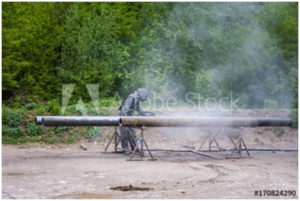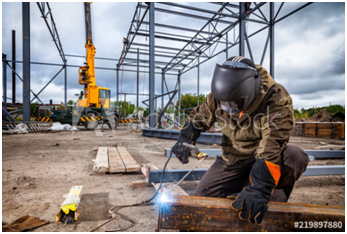 Jim Holden
Jim Holden
There appears to be an easier way to keep weld surfaces corrosion-free, thanks to the innovative work and attitude of Cortec Corporation. Cortec places a strong emphasis on finding ways to prevent rust and corrosion while minimizing environmental impact, for example, by providing water-based alternatives to traditional oil- and/or solvent-based coatings and rust preventatives. In the process, it has developed numerous solutions that are also more user-friendlybecause they reduce the messiness and cleanup needs of traditional materials. Often, these products are easier to remove or may not need to be removed at all. Now, that improved ease of use is showing increasing potential in the area of welding.
Weld surfaces must be clean and corrosion-free in order to achieve a good weld. This often requires extra labor time to grind off the corrosion or protective coating. In the spirit of finding a better approach to corrosion control on weld surfaces, Cortec’s Director of Energy & Engineered Solutions, Jim Holden, decided to investigate if two of Cortec’s water-based corrosion inhibitor coatings could be used for corrosion protection on weld surfaces without the inconvenience and side effects that come from mechanical removal.
Holden is a professional engineer with a long history of working in industrial settings, particularly in the energy sector. He first became convinced of the effectiveness and practicality of Cortec’s VpCI Technology as an engineer overseeing the preservation of new equipment during one power plant’s extended pre-commissioning phase. In trying a variety of corrosion inhibiting products, he noted the outstanding performance of Cortec VpCI and became a strong proponent of the Technology to the point of eventually joining the company. He also became a strong believer in Cortec VpCI coatings, which encouraged him to investigate the compatibility of the coatings with weld joints. From his knowledge of the coatings’ protective qualities and the needs of welders, he envisioned the potential to prevent corrosion while providing an easy alternative to mechanical cleaning and rust removal for welding surface prep.
Several years ago, Holden tested his theory on pipe samples coated with Cortec coatings—EcoShield 386 (a clear permanent coating) and VpCI-391 (a clear temporary/removable coating)—along with uncoated pieces for a control comparison. The coated pipes were welded according to the ASME Section IX, SMAW process and then sent for mechanical testing and examination of weld geometry.He later wrote a paper sharing the testing results, which demonstrated that neither of the coatings had a negative impact on the weld geometry or mechanical properties, thus opening up the possibility of simplifying weld surface prep for welders.
In an interaction, Jim Holden shares his thoughts behind doing the experiment and other insights he had on the subject from practical experience in the field. His answers offer some excellent guidance for welders looking for easier ways to achieve a corrosion-free weld surface.
What are some examples of what you have seen in the field that convinced you of the need for weldablecorrosion inhibitor coatings? What got you started investigating this?
Welders spending time grinding weld preps to remove corrosion which has a directimpact on cycle time. Many times this can lead to weld failure by changing the weldprep geometry sufficient to cause weld issues such as undercuts, lack of penetration, drop through, etc. I started looking into this during construction of a power plant and doing a root cause analysis on weld failures.
What kind of welding situations do you envision where welders will find these coatings a particular advantage?
I would say all weld applications as it eliminates the need to do hand grinding. All thatis required is to wipe with alcohol or other cleaner to remove any dust or other particulate matter that has settled on the surface. Of particular value is the ability to coat tubing https://www.cortecvci.com/whats_new/announcements/Welding-White-Paper.Final.pdf. that will be clad with an overlay material. Normally the process is tosandblast the tubing to remove all rust prior to doing the overlay. Not only is itapplicable to overlay applications but finning operations where heat transfer fins are welded to the tube OD.
Have you known anyone who has adopted either of these coatings for their own welding applications? Canyou describe?
Various companies are using it to protect weld preps on piping prior to welding. Alarge utility on the East Coast is in the midst of doing a trial coating tube ODs prior todoing an Inconel 625 overlay. A manufacturer of diesel engines is also evaluating foruse on all welded support structures.
When would you choose VpCI-391 over EcoShield 386, and vice versa?
You would use EcoShield 386 when there is a requirement to paint after welding.VpCI 391 cannot be painted over.
VpCI-391 is a removable coating that can be cleaned off with an alkaline wash. When would yourecommend welding right over it, and when would you recommend washing it off?
I personally cannot think of an application of where I would want to remove prior towelding. That being said you would need to demonstrate that it has no impact on weldproperties, so each weld process should be evaluated.
Any other comments on the subject?
Use of these products reduces cycle time and improves weld quality. However, eachtime you implement a new weld process you should perform mechanical andmetallurgical test to assure no change in weld properties.
For more information about EcoShield 386 and VpCI-391 coatings, contact Cortec Corporation: www.cortecvci.com

EcoShield 386 and VpCI-391 coatings demonstrate potential for avoiding the challenges of corroded weld surfaces on the job site. Image Courtesy : Cortec/Adobe Stock.

Sandblasting corroded surfaces prior to welding adds labor time to the weld project.
Image Courtesy : Cortec/Adobe Stock.






